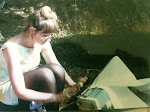Sometimes
I am empty for a very long time.
I
have no identity.
At
first it is frightening. And then it
turns
to an impulse of happiness. And
then
it stops.
Happiness:
I mean dead, somewhat.[1]
There
is always emptiness, lurking, like a ghost. Hiding behind the veil of an image,
this emptiness isn’t necessarily invisible. Perhaps it is something that you can
see, hiding, but not hidden. In contemporary art, this emptiness is often
encountered through work that destroys in the same moment that it creates, forcing
the object to hover somewhere between being and nothing.
Nothing
itself, as a sign, refers to nothing (no-thing). It is a void, nothing but its
own name.[2] In art
there is a relationship between the object and the void. It is a dialogue
between the image and nothing, a falling between the images, the slipping
between the crevices. There is always a gap.
I
think of a desert, which has these objects, and there are guns firing, and
smoke and dust, but no people. And I question if these objects too could be
art. And what would it take for them to be art. And if these new objects can be
called art, where did the things that we used to call art go, have they
disappeared?
Disappearance considers the object of art within a post medium, post-apocalyptic
environment. The notion of the object and its position within the gallery take
on the possibility of its own obsolescence. Objects collapse into the void. Or
perhaps the void is where they have emerged from, ghostly, singing, bedraggled
and wet.
What
has disappeared? It is not “no painting in an empty room”.[3] But
something that points towards other possibilities, something that talks of
non-presences. Heidegger describes it as a state which “Belongs to being and
yet remains a stranger to that which-is.”[4] The link
between vision and presence is broken and there is an engagement with nothing.
A hum. What is left when the object has disappeared? The echo, the voice of the
last thing said.
Say
a word over and over and over until that word has lost its meaning. With words
there is always a possibility to mean something, or to mean nothing at all. Objects,
like words, can lose their meaning, become aphasic. Instead of meaning
something specific, they talk about how they relate, through their presence, to
the objects and the people and the ideas around them. They ask: what is the
relation of this word to the next, of this image to the next, between these
objects, voices and gestures?
Reading
between the lines and the crevices of art is part of what makes it so interesting.
Don’t look for a narrative. But it is never purely about the materiality of the
object either. It is a passageway towards looking at how materiality can be
seen differently. Within the object, the image, there always exists something
that can connect with, not just out of recognition, but something that connects
you to thought. Deleuze said “what counts is the interstice between images,
between two images: a spacing which means each image is plucked from the void
and falls back into it.” Unlocatable. There is a dialogue with the outside of
representation and what lies beyond the object. Images are shaken, untied,
erased and reinscribed. Absence is a positive power for opening up, beyond
representation to where the object has disappeared.
[1] M Duras, No More, New
York, Seven Stories Press, 1998, p15.
[2] B Rotman, Signifying Nothing:
The Semiotics of Zero, London, Macmillan Press, 1987 p.98
[3] R Krauss, Theories of Art After
Minimalism and Pop, in H. Foster, (Ed) Vision and Visuality, Seattle,
Bay Press 1988, p.61
[4] B Bolt, Art Beyond
Representation, New York, I B
Tauris, 2004, p.31

No comments:
Post a Comment